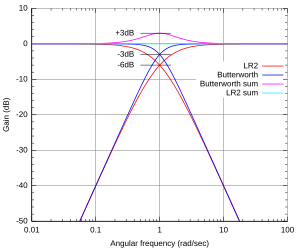Linkwitz–Riley filter
(Redirected from
Linkwitz-Riley filter
)| Linear analog electronic filters |
|---|

A Linkwitz–Riley (L-R) filter is an
group delay
around the crossover frequency.
Common types
Second-order Linkwitz–Riley crossover (LR2, LR-2)
Second-order Linkwitz–Riley crossovers (LR2) have a 12 dB/octave (40 dB/decade) slope. They can be realized by cascading two one-pole filters, or using a
op-amp
.
Fourth-order Linkwitz–Riley crossover (LR4, LR-4)
Fourth-order Linkwitz–Riley crossovers (LR4) are probably today's most commonly used type of audio crossover. They are constructed by cascading two 2nd-order Butterworth filters. Their slope is 24 dB/octave (80 dB/decade). The phase difference amounts to 360°, i.e. the two drives appear in phase, albeit with a full period time delay for the low-pass section.
Eighth-order Linkwitz–Riley crossover (LR8, LR-8)
Eighth-order Linkwitz–Riley crossovers (LR8) have a very steep, 48 dB/octave (160 dB/decade) slope. They can be constructed by cascading two 4th-order Butterworth filters.
See also
Wikimedia Commons has media related to Linkwitz–Riley filters.
References
- ^ Linkwitz, Siegfried H. (February 1976). "Active Crossover Networks for Noncoincident Drivers". Journal of the Audio Engineering Society. 24 (1): 2–8. Retrieved 2021-09-15.
- Siegfried H. Linkwitz (1976). "Active Crossover Networks for Noncoincident Drivers". Linkwitz Lab.
